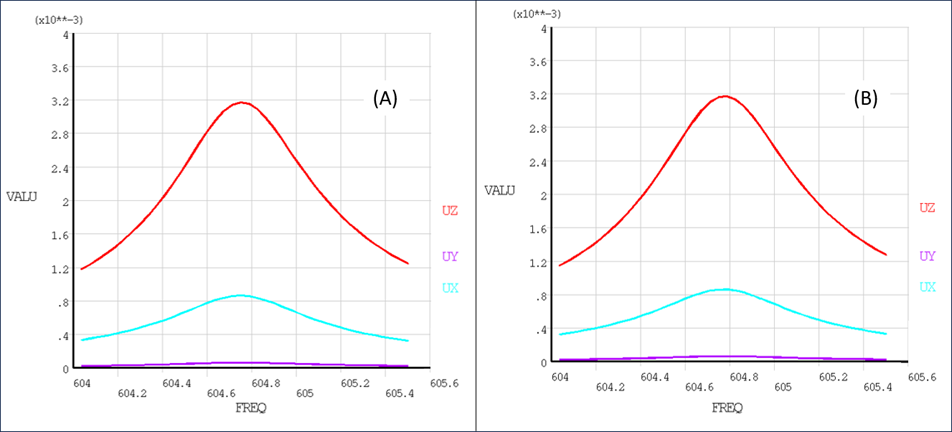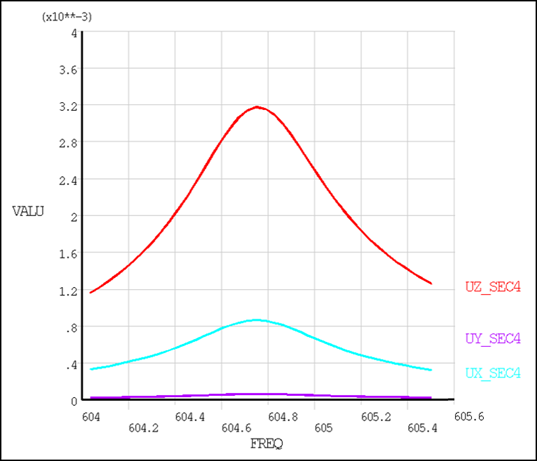The previous example of a simplified gear teeth multistage system (Linear Perturbation Harmonic Response Analysis of Two Stages) is used here to show how to perform a linear perturbation mode superposition (MSUP) harmonic response analysis. Specifically, it demonstrates the following key points:
Performing a linear perturbation MSUP harmonic response analysis.
Applying loading to 2 stages.
Applying an engine order load using a table having MSHI as a variable to automatically copy loads to the duplicate sectors (see Harmonic Index-based Tabular Loads).
Postprocessing any sector results in /POST26.
The example problem is presented in the following sections:
The multistage system is comprised of two axially aligned cyclic stages representing gears with, respectively, 24 and 45 teeth around their circumference as depicted in Figure 7.30: Multistage Model with Two Gear Teeth Stages.
For the base step of the linear perturbation (LP) multistage analysis, both HI = 0 stages undergo a rotational velocity and a temperature load. Both stages are then subjected to an engine order 2 excitation modeled using a single harmonic index (HI = 2) in an LP modal analysis of the system. Two engine order load vectors (one for each stage) are created in a modal restart step. The load vectors are applied using the LVSCALE command during the MSUP harmonic step.
A standard MSUP expansion pass is performed to recover the harmonic results on base and duplicate sectors. Full 360° /POST1 results are obtained by multistage cyclic expansion (MSOPT,EXPA). Frequency response plots on any sector are obtained by manually combining results on base and duplicate sectors in /POST26.
The following table describes the key steps and related commands used for the example analysis. See Input for the Analysis for the detailed command listing.
| Step | Description | Mechanical APDL commands |
| 1. | Read in stage meshes for base and duplicate sectors. | CDREAD,… |
| 2. | Duplicate meshes. | DUPLSTG.mac (macro provided) |
| 3. | Create stage components. | CM,... |
| 4. | Create HI = 0 stages and apply cyclic constraints. |
MSOPT,NEW,,,0 |
| 5. | Apply interstage constraints for all stage connections. | CEIMS,… |
| 6. | Enter the solution processor. | /SOLU |
| 7. | Specify static analysis options. |
ANTYPE,STATIC |
| 8. | Apply rotational load. | OMEGA,… |
| 9. | Specify temperature load. | TREF,… BF,,TEMP |
| 10. | Apply boundary conditions | D,… |
| 11. | Solve the analysis. | SOLVE |
| 12. | Exit and reenter the solution processor. | |
| 13. | Perform static LP restart and reform matrices for harmonic response |
ANTYPE,STATIC,RESTART,,,PERTURB PERTURB,MODAL SOLVE,ELFORM |
| 14. | Specify modal analysis options. |
MODOPT, … MXPAND,… |
| 15. | Modify used stages and delete unused stage clones. |
MSOPT,MODIFY |
| 16. | Apply interstage constraints for desired stages and stage clones. | CEIMS |
| 17. | Solve the analysis. | SOLVE |
| 18. | Exit and reenter the solution processor. | FINISH |
| 19. | Restart modal analysis to define load vectors to be used in the downstream harmonic analysis |
ANTYPE,MODAL,RESTART SF,… SFE… |
| 20. | Solve the analysis. | SOLVE |
| 21. | Exit and reenter the solution processor. | FINISH |
| 22. | Specify harmonic response options. |
HROPT,MSUP HARFRQ,… NSUBST,… |
| 23. | Apply nodal loads and load vectors. | F,… LVSCALE,… |
| 24. | Solve the analysis. | SOLVE |
| 25. | Exit and reenter the solution processor. | FINISH |
| 26. | Specify expansion pass options and solve. | EXPASS,ON NUMEXP,… |
| 27. | Post process the multistage results for all harmonics. |
MSOPT,EXPA,ALL,… SET,… |
| 28. | Generate contour plot. | PLNSOL,… |
| 29. | Postprocess frequency results | /POST26 NSOL,… PRCPLX,… PLVAR,… |
Download the zipped .cdb file and macro used for this example problem.
/com, ============================================ /com, ============================================ /com, MSUP Harmonic Solve: MS Model /com, ============================================ /com, ============================================ /filname,msMsupResp /com, ============================================ /com, MS Model Preparation /com, ============================================ cdread,db,msHarmStage,cdb /prep7 csys,1 ! duplicate mesh using macro (provided in example package) DUPLSTG,'stage1' DUPLSTG,'stage2' ! create cyclic edge CEs cmsel,s,_stage1_base_nod nsel,r,loc,y,0 cm,_stage1_cyclow_nod,node allsel cmsel,s,_stage1_base_nod nsel,r,loc,y,alpSec1 cm,_stage1_cychigh_nod,node allsel msopt,new,stage1,Nsec1,0 cecycms cmsel,s,_stage2_base_nod nsel,r,loc,y,0 cm,_stage2_cyclow_nod,node allsel cmsel,s,_stage2_base_nod nsel,r,loc,y,alpSec2 cm,_stage2_cychigh_nod,node allsel msopt,new,stage2,Nsec2,0 cecycms ! create interstage CEs cmsel,s,_stage1_base_nod nsel,r,loc,z,0 cm,intf1_stage1_nod,node allsel cmsel,s,_stage2_base_nod nsel,r,loc,z,0 cm,intf1_stage2_nod,node allsel ceims,,,stage1,stage2,,,,,,intf1_stage1_nod,intf1_stage2_nod ! components cmsel,s,load_stage1 cmsel,r,_stage1_base_nod nsel,r,loc,x,Ro_blad_stage1 nd0=ndnext(0) allsel cmsel,s,load_stage1 cmsel,r,_stage1_dupl_nod nsel,r,loc,x,Ro_blad_stage1 nd0dupl=ndnext(0) allsel cmsel,s,load_stage2 cmsel,r,_stage2_base_nod nsel,r,loc,x,Ro_blad_stage2 nd1=ndnext(0) allsel cmsel,s,load_stage2 cmsel,r,_stage2_dupl_nod nsel,r,loc,x,Ro_blad_stage2 nd1dupl=ndnext(0) allsel ! rotate nodes to postprocess in CSYS,1 csys,1 nsel,s,node,,nd0 nsel,a,node,,nd1 nsel,a,node,,nd0dupl nsel,a,node,,nd1dupl nrotat,all allsel finish /com, ============================================ /com, Static Base Step /com, ============================================ /solu antype,static nlgeom,on nsubst,2,2,2 ! boundary conditions cmsel,s,_stage1_base_nod cmsel,a,_stage1_dupl_nod nsel,r,loc,x,Ri_stage1 d,all,all allsel ! loading omega,,,600 tref,0 cmsel,s,_stage1_base_nod cmsel,a,_stage1_dupl_nod bf,all,temp,300 allsel cmsel,s,_stage2_base_nod cmsel,a,_stage2_dupl_nod bf,all,temp,100 allsel solve finish /com, ============================================ /com, LP Modal Step /com, ============================================ /SOLU antype,static,restart,,,perturb perturb,modal,,,dzerokeep solve,elform modopt,lanb,all,0,1000 mxpand,all,,,yes,,yes ! update harmonic index HI1=2 HI2=2 msopt,modify,stage1,HI1 cecycms msopt,modify,stage2,HI2 cecycms ceims,,,stage1,stage2,,,,,,intf1_stage1_nod,intf1_stage2_nod solve finish /com, ============================================ /com, Modal Restart to Create Load Vectors /com, ============================================ /solu antype,modal,restart modcont,on ! delete loads defined during static analysis omega, bfdele,all,all ! Apply tabular load to base sector only of stage 1. ! This will result in a engine order 2 excitation. EO = 2 *dim,press1_tab_re,table,1,,,MSHI press1_tab_re(1,0) = EO press1_tab_re(1,1) = 1e6 *dim,press1_tab_im,table,1,,,MSHI press1_tab_im(1,0) = EO press1_tab_im(1,1) = 0.25e6 cmsel,s,load_stage1 cmsel,r,_stage1_base_nod sf,all,pres,%press1_tab_re%,%press1_tab_im% allsel solve ! Apply tabular load to base sector only of stage 2. ! This will result in a engine order 2 excitation. sfdele,all,all EO = 2 *dim,press2_tab_re,table,1,,,MSHI press2_tab_re(1,0) = EO press2_tab_re(1,1) = 1000000 *dim,press2_tab_im,table,1,,,MSHI press2_tab_im(1,0) = EO press2_tab_im(1,1) = 0 cmsel,s,load_stage2 cmsel,r,_stage2_base_nod sf,all,pres,%press2_tab_re%,%press2_tab_im% allsel solve finish /com, ============================================ /com, LP MSUP Harmonic Response /com, ============================================ /SOLU antype,harmic hropt,msup Nfrq=40 Fmin=604 Fmax=605.5 harfrq,Fmin,Fmax nsubst,Nfrq ! loading sfdele,all,all lvscale,1.0,1 lvscale,1.0,2 kbc,1 ! damping dmpstr,1e-3 solve finish /solu expass,on numexp,all solve finish /post1 msopt,expa,all,all set,1,20 rsys,1 /graphics,power /view,,1,1,1 /edge,,1 /show,png,rev plnsol,u,sum *get,umax,plnsol,,max plnsol,s,eqv *get,seqvmax,plnsol,,max *stat,umax *stat,seqvmax finish /POST26 numvar,50 nsol,2,nd0,u,x ! base sector results - stage1 nsol,3,nd0,u,y nsol,4,nd0,u,z nsol,5,nd0dupl,u,x ! duplicate sector results - stage1 nsol,6,nd0dupl,u,y nsol,7,nd0dupl,u,z nsol,12,nd1,u,x ! base sector results - stage2 nsol,13,nd1,u,y nsol,14,nd1,u,z *afun,deg sector=4 prod,22, 2,,,,,, cos((sector-1)*HI1*alpSec1) ! results in sector 4 prod,25, 5,,,,,,-sin((sector-1)*HI1*alpSec1) add,32,22,25,,UX_SEC4 prod,23, 3,,,,,, cos((sector-1)*HI1*alpSec1) prod,26, 6,,,,,,-sin((sector-1)*HI1*alpSec1) add,33,23,26,,UY_SEC4 prod,24, 4,,,,,, cos((sector-1)*HI1*alpSec1) prod,27, 7,,,,,,-sin((sector-1)*HI1*alpSec1) add,34,24,27,,UZ_SEC4 prcplx,1 /com /com ------ TIP OF BLADE - STAGE 1 - SECTOR 1 ------ /com plvar,2,3,4 /com /com ------ TIP OF BLADE - STAGE 1 - SECTOR 4 ------ /com plvar,32,33,34 /com /com ------ TIP OF BLADE - STAGE 2 ------ /com plvar,12,13,14 FINISH
The analysis results are shown in the following figures. The analysis results of the multistage LP MSUP harmonic analysis match those of the multistage LP harmonic analysis. The similarity of these results to those from the reference full 360° harmonic analysis verifies the accuracy of the more efficient multistage cyclic symmetry approach.
Figure 7.37: Stage 1 Displacement Frequency Response – Sector 1 for Multistage MSUP (A) and Reference Full 360° (B)

Figure 7.39: Stage 2 Displacement Frequency Response – Sector 1 for Multistage (A) and Reference Full 360° (B)





